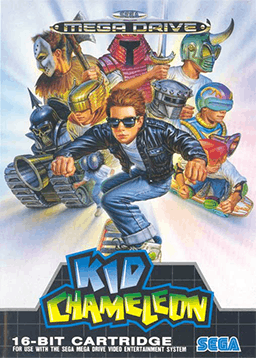Kid Chameleon (video game)
| Kid Chameleon | |
|---|---|
|
PAL boxart | |
| Developer(s) | Sega Technical Institute |
| Publisher(s) | Sega |
| Director(s) | Graeme Bayless |
| Designer(s) |
Broderick Macaraeg Hoyt Ng Bill Dunn Steve Woita |
| Programmer(s) |
Mark Cerny Steve Woita Bill Willis BC. Tchiu Le Scott Chandler |
| Artist(s) |
Craig Stitt Yasushi Yamaguchi Alan Ackerman Brenda Ross Paul Mica |
| Composer(s) | Mark Miller |
| Platform(s) | Mega Drive/Genesis |
| Release date(s) | May 28, 1992 |
| Genre(s) | Platformer |
| Mode(s) | Single player, multiplayer |
Kid Chameleon is a 1992 platform game released for the Sega Genesis/Mega Drive. The premise of the game is that the main character, Casey, can use masks to change into different characters in order to use different abilities. It was later released in Japan as Chameleon Kid (カメレオン キッド Kamereon Kiddo).
The game is also a part of the Sega Genesis Collection for the PlayStation 2 and PlayStation Portable. It was released for the Virtual Console in Japan on May 22, 2007; North America on May 28, 2007; and Europe on June 1, 2007. It was also released in addition to a series of other Sega games, including Shining Force and Comix Zone, in Sega Smash Pack 2. The game has also appeared in Sonic's Ultimate Genesis Collection for Xbox 360 and PlayStation 3.
Gameplay
The player, as Kid Chameleon, progresses through a series of levels, containing an array of deadly enemies and obstacles. Most levels contain a flag, which is the primary goal of each level, from which the player progresses to the next level. However, a number of teleporters throughout the game can warp the player not only to different places in the same level, but also to different levels, and sometimes to an entirely different path through the game. At the end of the game, Kid fights and defeats the final boss, Heady Metal. Kid Chameleon contains 103 levels, of which only about half are on the "main path" (traversing levels only by flags), and also counts 32 smaller unnamed levels, simply called "Elsewhere". Despite the game's considerable length, there was no password system or other method of saving the game (although re-releases in compilations and Virtual Console include their own save features). There are several bonuses that can be earned at the end of certain levels (in which the flag is touched), including beating a time limit, not getting hit and not collecting any prizes.
As Kid Chameleon moves through the game's levels, he gains access to masks that transform him into different characters. Each character has different special abilities and varying amounts of hit points. Collecting a mask that the player is already wearing will restore its health. The sheer amount of variety in gameplay due to the various characters is part of what gave Kid Chameleon such an addictive style; few levels repeated the same structure and they usually had specific strategies and characters to be beaten. In addition to the offensive abilities of each form, the Kid could also defeat enemies by jumping on them, although he may take damage from some enemies by doing so. Each form can also make use of Diamond Powers which require diamonds collected in the game to use, accessed by pressing A + Start. Players lose a life if Kid Chameleon loses all his hit points in human form, is crushed, falls into bottomless pits or lava or touches the drill wall which appears in certain levels, or if time runs out. Extra lives and continues can be found in the game, with additional lives awarded for every 50,000 points.
Reception
| Reception | ||||||||||||||||||||||
|---|---|---|---|---|---|---|---|---|---|---|---|---|---|---|---|---|---|---|---|---|---|---|
| ||||||||||||||||||||||
Mega placed the game at #35 in their Top Mega Drive Games of All Time,[2] and Retro-Sanctuary placed the game at #31 in their Top 100 Mega Drive Games of All Time.[3]MegaTech magazine said it was let down by the lack of challenge.
Comic adaptation
In early 1993, Kid Chameleon gained his own comic strip in the new Fleetway publication Sonic the Comic. The first strip ran from issues 7–12 and featured Casey entering the Wildside to rescue his friend Suzy, with a disembodied presence known as "The Voice" giving him advice and encouragement. Through each issue he changed into one of the different personas: Red Stealth, Eyeclops, Micromax, Berzerker and finally Iron Knight, before his Chameleon powers ran out and he had to take down a powerful enemy as his normal self. While he and Suzy escaped Wildside, the story ended with Casey discovering local school bully Brad was also trapped in Wildside. In issues 54–59 he returned again to rescue Brad, this time turning into Skycutter, Juggernaut, Maniaxe and Cyclone. Here he discovered that The Voice had a more sinister agenda and was keeping children from all over the world prisoner in the Islecatraz gulag, using Brad as warden. Casey, as Cyclone, destroyed Islecatraz and freed everyone from Wildside, but when it became clear only one more person could escape, Brad sacrificed himself as penance for his sins so Casey could escape. The ending was ambiguous, with a showdown being threatened between Casey and The Voice, but Fleetway did not produce any more strips.
References
- ↑ MegaTech rating, EMAP, issue 5, page 78, May 1992
- ↑ Mega magazine issue 1, page 76, Future Publishing, Oct 1992
- ↑ http://retro-sanctuary.com/Top-100-Megadrive-Games-Page-1.html
